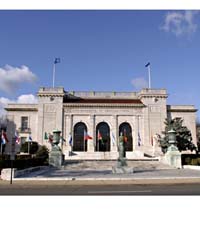History
The Organization of American States, the oldest regional international organization in the world, traces its origins to the Congress of Panama, convoked by Simon Bolivar in 1826 and attended by representatives from Central and South America. That congress drafted the Treaty of Perpetual Union, League and Confederation, signed by the delegates but ratified only by Gran Colombia (today's Colombia, Ecuador, Panama, and Venezuela).
Hemispheric countries continued the discussion of an inter-American system during the rest of the 19th century. The first concrete step was taken in 1889, when the First International Conference of American States convened in Washington, DC. On April 14, 1890, delegates created the International Union of American Republics "for the prompt collection and distribution of commercial information." They also established the Commercial Bureau of the American Republics in Washington as the Union's secretariat, with the participation of 18 Western Hemisphere nations, including the United States. In 1910, the Commercial Bureau became the Pan American Union, and American philanthropist Andrew Carnegie donated $5 million to construct a permanent headquarters in Washington, DC, which is today the historic OAS building on 17th Street & Constitution Avenue, NW.
The experience of World War II convinced hemispheric governments that unilateral action could not ensure the territorial integrity of the American nations in the event of extra-continental aggression. To meet the challenges of global conflict in the postwar world and to contain conflicts within the hemisphere, they adopted a system of collective security, the Inter-American Treaty of Reciprocal Assistance (Rio Treaty) signed in 1947 in Rio de Janeiro.
The OAS Charter was adopted at the Ninth International Conference of American States in Bogotá, Colombia on April 30, 1948. The OAS marked the 60th anniversary with a ceremony at OAS headquarters in Washington, D.C. on April 30, 2008.
The OAS Charter reaffirmed the fundamental rights and duties of states, proclaimed the goals of the new organization, and established its organs and agencies. That conference also approved the American Treaty on Pacific Settlement (Pact of Bogotá) and the American Declaration of the Rights and Duties of Man. The OAS Charter proclaims the organization to be a regional agency within the UN system.
The basic objectives of the OAS, as laid out in its Charter, are to strengthen peace and security; promote the effective exercise of representative democracy; ensure the peaceful settlement of disputes among members; provide for common action in the event of aggression; seek solutions to political, juridical, and economic problems that may arise; promote, by cooperative action, economic, social, educational, scientific, and cultural development; and limit conventional weapons so as to devote greater resources to economic and social development.
Concern over slow economic development led the United States and 19 other OAS members to establish the Inter-American Development Bank in 1959. This reflected concern that the World Bank, which included Latin American countries in its list of eligible borrowers, was preoccupied with infrastructure and not sufficiently attuned to the need for "social" lending as well as industrial and agricultural aid. In 1960, the OAS adopted the Act of Bogotá, which called for a hemisphere-wide commitment to economic and social development. This set the stage for OAS support for the Alliance for Progress.
The 1948 OAS Charter has been amended four times: by the 1967 Protocol of Buenos Aires, which went into effect in February 1970; by the 1985 Protocol of Cartagena, which took effect in November 1988; by the 1993 Protocol of Managua, which took effect in March 1996; and by the 1992 Protocol of Washington which took effect in September 1997.
The Buenos Aires Protocol created the annual General Assembly and gave equal status to the Permanent Council; the Economic and Social Council; and the Council for Education, Science, and Culture. The Cartagena Amendments strengthened the role of the Secretary General; provided procedures to facilitate peaceful settlement of disputes; removed obstacles, involving border disputes, to the entry of Belize and Guyana; and called for strengthening economic and social development by taking measures to increase trade, enhance international financial cooperation, diversify exports, and promote export opportunities.
The Managua Protocol created the Inter-American Council for Integral Development (CIDI) to replace the Economic and Social Council and the Council for Education, Science, and Culture. The key objectives of CIDI are to serve as a forum for technical policy-level discussions on matters related to development, to be a catalyst and promoter of development activities in response to mandates from the Summits of the Americas, and to strengthen a hemispheric partnership among OAS countries to promote cooperation for development and to help eliminate extreme poverty in the hemisphere.
Ratification of the Washington Protocol made the OAS the first regional political organization to permit suspension of a member whose democratically constituted government is overthrown by force. This protocol also amended the OAS Charter to include the eradication of extreme poverty as one of the organization's essential purposes.
The OAS helps preserve democracy by mobilizing the hemisphere in the face of threats to democratic rule. It acted under the mandate of General Assembly Resolution 1080 (1991) to support democracy in Haiti, Peru, Guatemala, and Paraguay. It also provides development and other assistance designed to strengthen democratic institutions, observe elections, promote human rights, increase trade, fight drugs, and protect the environment.
